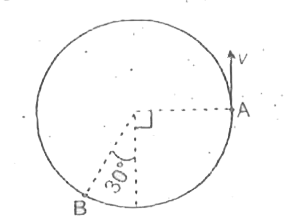A body revolves with constant speed v in a circular path of radius r. the magnitude of its average acceleration during motion between two points in diametrically opposite direction is
Zero
v2r
2v2πr
v22r
The correct Answer is:C
To find the magnitude of the average acceleration of a body moving with constant speed v in a circular path of radius r between two diametrically opposite points, we can follow these steps:
Step 1: Understand the motion
The body is moving in a circular path with a constant speed v. We need to analyze the motion between two points that are diametrically opposite on the circle.
Step 2: Identify the points
Let’s denote the two points as Point 1 and Point 2, which are diametrically opposite to each other. The body moves from Point 1 to Point 2, passing through the center of the circle.
Step 3: Determine the time taken
The distance traveled from Point 1 to Point 2 is half the circumference of the circle. The circumference C of a circle is given by:
C=2πr
Thus, the distance for half the circle (from Point 1 to Point 2) is:
Distance=C2=πr
The time t taken to travel this distance at constant speed v is:
t=Distancev=πrv
Step 4: Determine the change in velocity
At Point 1, the velocity →v1 can be considered in the horizontal direction (let's say to the right), and at Point 2, the velocity →v2 will be in the opposite direction (to the left). Therefore, we can express these velocities as:
→v1=v(to the right)
→v2=−v(to the left)
The change in velocity Δ→v is given by:
Δ→v=→v2−→v1=−v−v=−2v
Step 5: Calculate the average acceleration
Average acceleration →aavg is defined as the change in velocity divided by the time taken:
→aavg=Δ→vt=−2vπrv=−2v2πr
The magnitude of the average acceleration is:
|→aavg|=2v2πr
Final Answer
The magnitude of the average acceleration during the motion between two points in diametrically opposite directions is:
|→aavg|=2v2πr
The body is moving in a circular path with a constant speed v. We need to analyze the motion between two points that are diametrically opposite on the circle.
Let’s denote the two points as Point 1 and Point 2, which are diametrically opposite to each other. The body moves from Point 1 to Point 2, passing through the center of the circle.
The distance traveled from Point 1 to Point 2 is half the circumference of the circle. The circumference C of a circle is given by:
C=2πr
Thus, the distance for half the circle (from Point 1 to Point 2) is:
Distance=C2=πr
The time t taken to travel this distance at constant speed v is:
t=Distancev=πrv
At Point 1, the velocity →v1 can be considered in the horizontal direction (let's say to the right), and at Point 2, the velocity →v2 will be in the opposite direction (to the left). Therefore, we can express these velocities as:
→v1=v(to the right)
→v2=−v(to the left)
The change in velocity Δ→v is given by:
Δ→v=→v2−→v1=−v−v=−2v
Average acceleration →aavg is defined as the change in velocity divided by the time taken:
→aavg=Δ→vt=−2vπrv=−2v2πr
The magnitude of the average acceleration is:
|→aavg|=2v2πr
The magnitude of the average acceleration during the motion between two points in diametrically opposite directions is:
|→aavg|=2v2πr
Similar Questions
A body revolves with constant speed vin a circular path of radius r.The magnitude of its average acceleration during motion between two points in diametrically opposite direction is
View SolutionA particle of mass m moves with constant speed v on a circular path of radius r. Find magnitude of average force on it in half revolution.
View Solution
Knowledge Check
Motion of a body with constant speed in a circular path is called:
ACirculatory motionBOscillatory motionCNon-uniform circular motionDUniform circular motionIf a body moves along circular path of constant radius, then the magnitude of its acceleration will be
AuniformBzeroCvariableDnot to be decided from the informationA body moves with a constant speed along a curved path its acceleration :
Ais zeroBis parallel to its velocityCcan make any arbitrary angle with its velocityDis perpendicular to its velocity
A particle of mass m moves with constant speed v on a circular path of radius r as shown in figure. The average force on it during its motion from A to B is

View SolutionA particle is moving with a constant speed v in a circle. What is the magnitude of average velocity after half rotation?
View SolutionA particle moves with constant speed v along a circular path of radius r and completes the circle in time T. The acceleration of the particle is
View SolutionIF a body moves with constant speed along a curved path,its tangential acceleration is
View SolutionA particle of mass M moves with constant speed along a circular path of radius r under the action of a force F. Its speed is
View Solution
